How to Generate Fashion Label Tags for Your Store’s Clothes
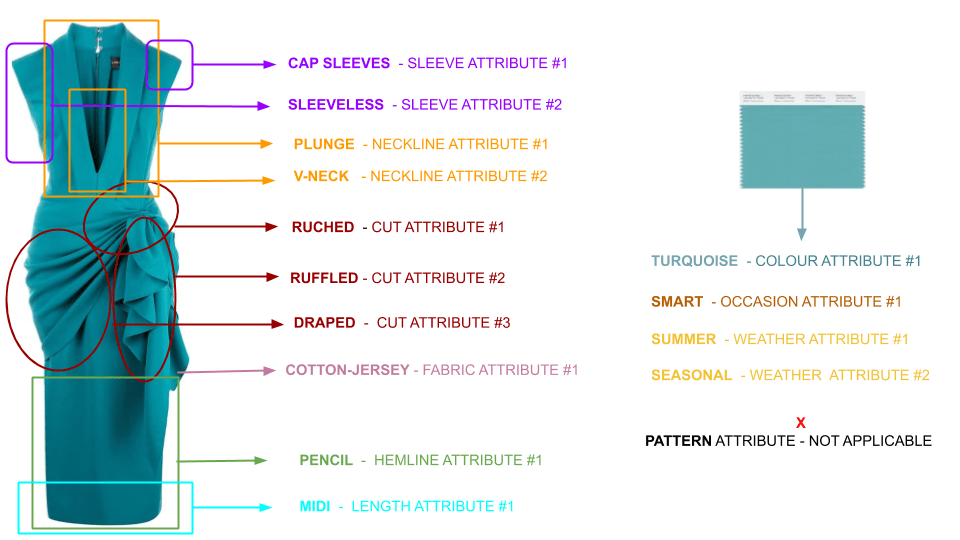
From having an active presence on social media to sending out relevant retargeting campaigns, there are many things brands can do to stand out from the crowd. However, none of these things matter if a store doesn’t nail down the basics of retail success. This includes generating accurate and rich fashion label tags for their clothes.
What Are Fashion Label Tags?
Fashion label tags are product tags (or product metadata) that allow customers to filter product results by specific attributes, such as a garment’s brand, colour, or fabric.
For example, if a shopper searches for a “yellow strappy linen dress,” their search query indicates that they want to buy a dress that is:
- Made from linen
- Is yellow
- Has straps
If a retailer has created and assigned the right tags for their products, then the browser will see the following results:
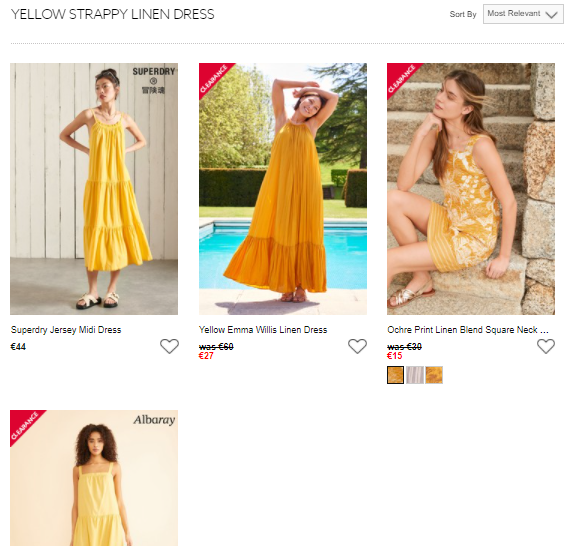
On the other hand, if they haven’t, the customer may instead see the following results:
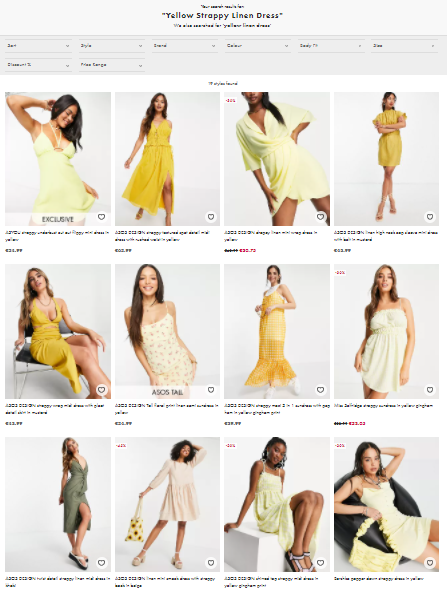
While the second example isn’t the worst — and there are a few yellow strappy dresses made from linen on the results page — it should not include dresses that have sleeves, nor should it include dresses that are any other colour than yellow. As it is, it does, which means that browsers are shown items they aren’t necessarily interested in buying.
Why Are Fashion Label Tags Important?
For customers, the main benefit of fashion label tags is that it’s possible to find the perfect product quickly.
If someone types in “yellow strappy linen dress” into an external search engine (like Google), they know that they’ll see results from brands that have items in stock that match these criteria.
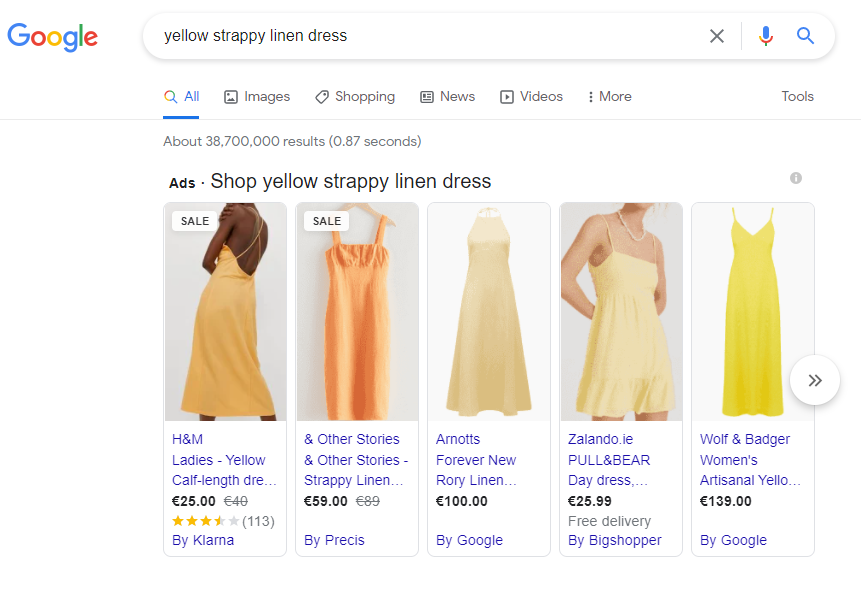
However, if your products don’t have fashion label tags attached to them or they’re inconsistent or incorrect, then your stock won’t appear in these results.
Consequently, the shopper will assume that you don’t have what they’re looking for, and you’ll miss out on a sale. The same can be said for customers that look for particular items via the search bar/filters/menu navigation of your e-commerce store. In either case, customer experience suffers, and browsers that could have converted will more than likely end up shopping elsewhere.
On the other hand, for e-commerce sites, fashion label tags can help brands understand customer behaviour, which, in turn, can lead to better business decisions.
For instance, if a specific dress is selling incredibly well, retailers may want to know why that is so. Is it the silhouette of the dress that people like? The fabric? The neckline? The sleeves? Once they understand what makes the dress so popular, they can order other garments with the same attributes. Similarly, they can stop the production of items with attributes that are unpopular.
By knowing what specific attributes draw customers to particular items, retailers can also personalise each individual’s shopping experience. To go back to our previous example, if a person looks for yellow strappy linen dresses, the brand in question can assume that they like:
- Dresses
- Linen garments
- Bright colours
- Strappy sleeves.
The brand can then recommend visually similar alternatives underneath each product, which can be particularly helpful if the item a customer wants is out of size or stock.
Similarly, some brands may display product recommendations on their homepage when a browser returns to the online store in the future. If they can show items that are similar to the ones that the shopper was interested in the last time they were on the site, the chances of a sale are much higher.
How to Generate Fashion Label Tags for Your Store’s Clothes
When it comes to generating fashion label tags for a store’s clothes, retailers have two options: manual or automatic fashion label tagging.
Manual

Manual fashion label tagging is exactly what it sounds like: retail staff (usually the merchandising team) manually creating and applying fashion labels to photos within the brand’s product catalogue. A woefully outdated method, manual fashion label tagging comes with a number of disadvantages.
To start with, manual product tagging is time-consuming and difficult to scale. Even for retailers with small product catalogues, tagging items manually still takes up a lot of time and effort. For brands with hundreds of thousands of products and an inventory that is constantly changing, manual product tagging is completely unsustainable both from an operational and a financial point of view.
Even if a retailer hires more staff — which, depending on where they’re based, could be very expensive — getting products to market in a timely manner may still be a struggle. Unfortunately, this could have a negative effect on items that are seasonal or trending.
Furthermore, there is no way to guarantee that every product will be tagged appropriately or that staff won’t make mistakes (think spelling mistakes or incorrect category mapping) that could lead to lost sales.
Automatic
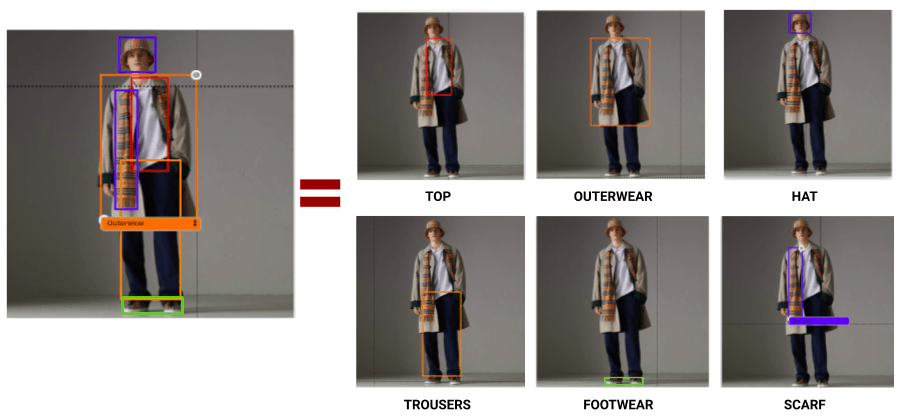
Thanks to advances in AI technology, AI can scan product images and tag clothes consistently, applying multiple attribute labels based on a predefined fashion taxonomy — all without any involvement from you or your staff.
However, that’s not to say that automatic fashion label tagging requires absolutely no thought on your part. To make it as hands-free as possible, you’ll want to make sure that whichever automatic attribute tagging tool you choose can do the following:
- Tag products via a hierarchical image tagging system that supports mutually exclusive and non-mutually exclusive tags. This allows you to use higher-level categories (for example, “dress”) and subcategories (“slip dress”) that are mutually exclusive (i.e., they highlight the exclusive attributes of an item) as well as attributes (“strappy sleeve,” “yellow,” and “casual occasion”) that are non-mutually exclusive (i.e., you can add multiple tags to each item).
- Detect and tag multiple products in product photos via visual search. Ideally, you want the tagging tool to be able to do this with both editorial images and user-generated photos.
- Tag products with the most relevant data to your products and business. For this, you’ll want a tool that has fashion-specific data sets — like Intelistyle.
- Give you the option to review tags. The best product tagging tool will allow you to evaluate and modify product tags created automatically.
AI not only makes the process of generating and applying fashion label tags faster and more cost-effective, but it also ensures more consistent, detailed, and accurate search results. The reason why is that AI-powered tagging tools tend to notice even the smallest apparel details and synonyms. So, even if a browser’s search query doesn’t precisely align with the wording in your product catalogue, AI-powered tags will allow them to see the item they’re looking for anyway.
Another advantage of automatic fashion label tagging tools is that they can tag your inventory in real-time. Customers can therefore see new or restocked items as soon as they become available. If you stock the same items as other retailers, this can give you a competitive advantage as shoppers will know to check your site first.
Generating Fashion Label Tags Just Got Easier
Great fashion label tags are the foundation of any successful fashion business. It doesn’t matter how sleek your online store is or how amazing your marketing campaigns are. If you fail to show customers the items they’re looking for or if you keep stocking items that no one wants, making it in today’s highly competitive environment is going to be an uphill struggle.
However, while having relevant product attributes is crucial, that doesn’t mean that your team has to spend hours trying to get it right. Luckily, there are plenty of tools out there that can do all the hard work for you — and do it better.
Intelistyle is one such tool, and it comes with many other benefits. Check out what else we have to offer, and get in touch with us today to talk about how we can help you bring customers into your store in 2021 and beyond.
Book a free consultation
